Projects
QLM open day
Join us for the QLM open day on the 5th of March at 1pm in the seminar room of building 46 when we will present all available positions for the next academic year. We will review the first round of PhD applications by 30th of March. Therefore, students are encouraged to apply before that.
On-chip single-photon sources for quantum information technology applications
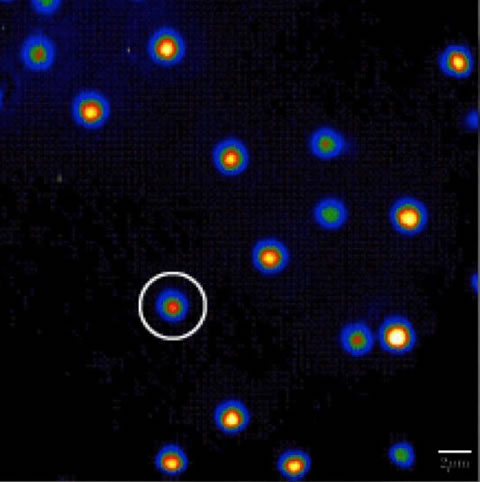
Non-classical optical sources emitting single photons are required for applications in quantum information science. Quantum cryptography, for instance, exploits the fundamental principles of quantum mechanics to provide unconditional security for communication. An essential element of secure key distribution in quantum cryptography is an optical source emitting pulses containing one and only one photon, a so-called triggered single-photon source. Since measurements unavoidably modify the state of a single quantum system, an eavesdropper cannot gather information about the secret key without being discovered, if the pulses used in transmission contain only one photon. The field of quantum photonics has seen a tremendous development in recent years, leading to major advances in the understanding and control of solid-state systems at the quantum level. Current technology allows the realization of nanophotonic structures containing quantum emitters that enable single photons to be emitted on demand. These are the building blocks of many quantum information protocols and very exciting prospects seem within reach. The development of quantum information technology is expected to have an impact on everyday life, providing secure communication and faster and more efficient computation schemes.
This project is focused on the study of solid-state single-photon sources, like semiconductor quantum dots (see image), from a fundamental perspective and in view of applications. These nanostructures resemble artificial atoms for many of their properties, most importantly the three dimensional confinement of the carriers, that results in the discreteness of the energy levels and thus sharp emission lines, and they can be embedded in on-chip optical cavities and waveguides, to control their emission properties and the propagation of light.
The student will have access to the fabrication facilities of the £120M Nanofabrication Facility of the Mountbatten clean room (http://www.southampton-nanofab.com), where the photonic devices (optical cavities and waveguides) will be fabricated. She/he will get hands-on experience in near-infrared and visible spectroscopy for the optical characterisation of single-photon sources.
For more information, please visit our group website at http://www.quantum.soton.ac.uk and contact Dr Luca Sapienza (l.sapienza@soton.ac.uk).
Light confinement in disordered photonic crystals as an alternative platform for quantum photonics
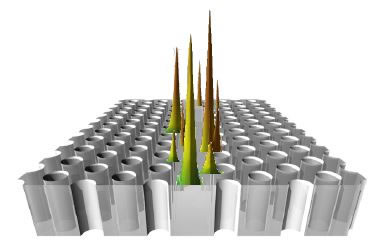
Technological advances allow us to control light at the nanoscale, via highly engineered devices where light can be trapped and guided. However, very accurate fabrication techniques limit the scalability and wide application of such devices. We have recently demonstrated that imperfections, introduced in the device fabrication, can be used to add functionalities and control the light-matter interaction.
One of the major advantages in using “disordered” photonic crystal waveguides to confine light derives from the fact that, in a single waveguide, several cavity modes can co-exist (see image), without the need of fabricating a series of highly engineered photonic crystal cavities. Furthermore, their spatial extension can reach the micron size and, therefore, they show great potential for realizing photonic networks, as spatially extended coupled cavities, so-called necklace states, can spontaneously form.
The student will fabricate disordered photonic crystal waveguides whose properties are tailored to a specific emitter, thanks to the positioning technique that we have developed. She/he will then characterize the Anderson-localized cavity modes by measuring wavelength, quality factors and spatial extension of the optical modes. The ultimate goal will be the creation of a photonic architecture where the emission from a single emitter is boosted by the coupling to an Anderson-localized cavity. The quantum light will propagate thanks to the hopping from cavity to cavity via coupled necklace states and will be used in quantum information protocols, based, for instance, on interference of single photons. Fabricating photonic crystal waveguides without the stringent requirement of nanometre scale precision in the position, shape and size of the air holes will make the process inherently cheaper and more scalable, since lower resolution tool and faster processes, with no iterations, can be utilised.
For more information, please visit our group website at http://www.quantum.soton.ac.uk and contact Dr Luca Sapienza (l.sapienza@soton.ac.uk).
Levitated magnetomechanics for fundamental tests of quantum theory
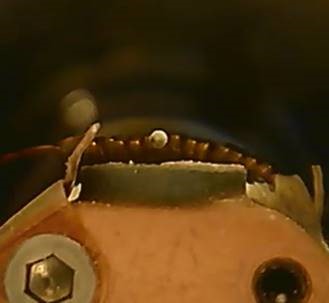
Levitated optomechanics of nanoparticles has been demonstrated as a powerful tool for ultrasensitive force sensing and for the investigation of quantum mechanics and fundamental physics issues. One of the most intriguing opportunities is the experimental test of theories predicting the breakdown of quantum mechanics when moving from the nanoscale towards the macroscale. For instance, spontaneous wave function collapse models or gravitational reduction models have been proposed to reconcile the fuzziness of quantum mechanics with the definiteness of the macroscopic world and with gravity. In this respect, a known issue of optical levitation is the laser-induced heating of the levitated nanoparticle, which prevents experiments to be performed in an ultra-isolated low temperature environment. A possible solution is to replace optical levitation with passive magnetic levitation based on hybrid magnetic/superconductor systems. This approach has the unique potential to provide the ultimate isolation required for extremely accurate tests of quantum mechanics.
The main goal of the project is the setup of a cryogenic levitation experiment with micromagnetic particles able to achieve extreme vibrational, electromagnetic and thermal isolation. Subsequently, this almost ideal environment will be exploited to perform fundamental physics experiments, such as the test of spontaneous collapse theories based on ultrasensitive force measurements. Superconducting Quantum Interference Devices (SQUIDs) will be employed to detect the levitated particle motion with minimal measurement heating and disturbance. A special cryostat designed to reach sub-kelvin temperature under ultrahigh vacuum conditions and ultralow vibrational noise will be available for the project. An alternative approach based on electrical trapping techniques will be also explored.
For more information, please visit our group website at http://phyweb.phys.soton.ac.uk/matterwave/html/ and contact prof. Hendrik Ulbricht (h.ulbricht@soton.ac.uk).
Optomechanics and gravity
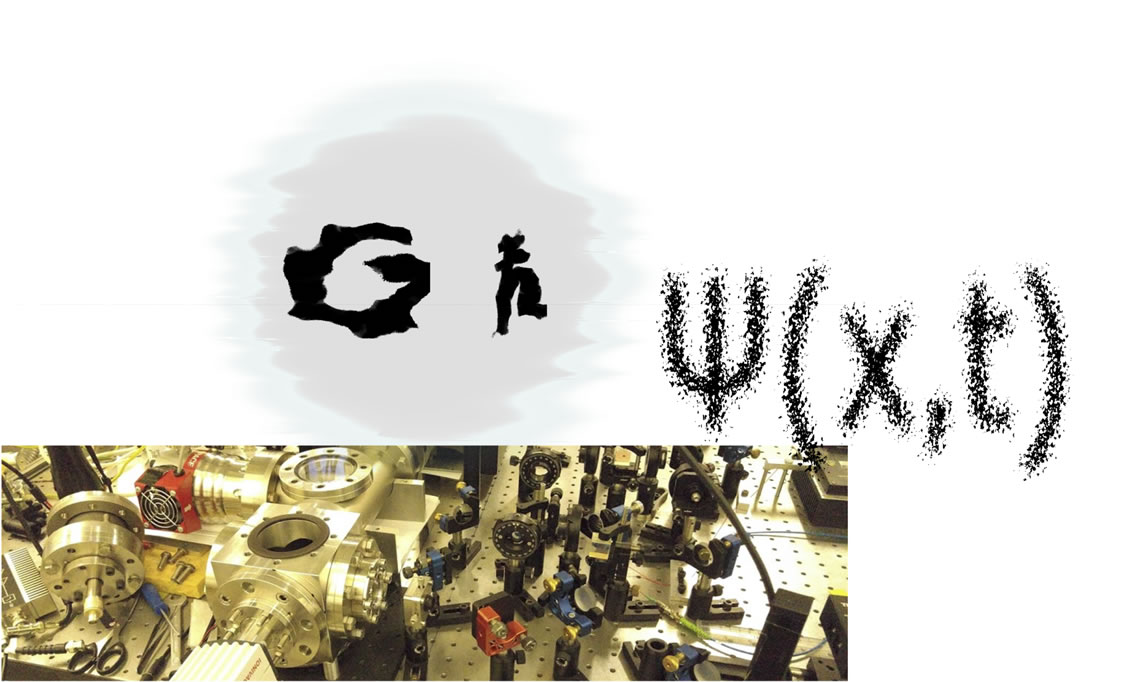
We are looking for candidates who want to pursue a theoretical PhD in Optomechanics and low energy Quantum gravity. The selected applicant will investigate optically levitated systems in situations, where gravitational interactions become important. This research project offers the possibility to, on the one hand, be close to state of the art experiments, while on the other hand, explore theoretically the elusive relationship between quantum mechanics and gravity.
The PhD research project will focus on developing proposals for testing gravitational interactions in optomechanical experiments. These experiments, which are already exploring the quantum-to-classical transition, offer a realistic possibility of also testing gravitational interaction in a quantum mechanical regime, using a relatively simple table-top setup. Moreover, rival theories, such as modified theories of gravity and gravity-based quantum spontaneous collapse models, could also be tested. The modelling of the post-Newtonian and non-unitary corrections to the dynamics will incorporate methods from General relativity as well as from Open quantum theory. Particular emphasis will be given to Quantum gravity phenomenology that is testable with current experiments in the near future.
Applicants should possess a MSc Physics and have a good background in theoretical physics. Previous experience in General relativity, Open quantum theory, and Optomechanics will be an advantage. Other highly motivated candidates will also be considered and are encouraged to apply.
The successful candidate will conduct research under the supervision of Prof. Hendrik Ulbricht in the Quantum Light and Matter group at the University of Southampton. The selected applicant will also take part in collaborations with researches from other Universities. For further enquiries write to h.ulbricht@soton.ac.uk.
Macroscopic Quantum Mechanical States

Quantum mechanical effects are not limited to the microscopic. However we find that as the mass of an object increases, the classical domain supersedes quantum mechanical effects. This phenomena conventionally explained by quantum decoherence theory can be understood to come about due to “leaking” of information to the environment about the position and momentum of the object. Thus large objects lose quantum coherence faster than say microscopic objects. However, what happens when you completely isolate an object from its environment? Will the object continue to behave quantum mechanically? To realise this experimentally, one requires an object that can be prepared to behave quantum mechanically, but also one requires techniques to detect its quantum behaviour without destroying the quantum mechanical state.
Here at Southampton we have developed a novel setup whereby using 1550 nm laser light we are able to trap and isolate 100 nm particles in ultra-high vacuum. This new and thriving field is known as Levitated Optomechanics. Already, we have demonstrated the ability to control the centre-of-mass motion of the particle, by cooling its motion by a factor of a million. That is 150 phonons away from ground state.
This project, thus aims to further this work to reach the quantum ground state of the motional states of a levitated mechanical oscillator. The student will utilise and further develop continuous weak measurement and quantum feedback protocols. Implement experimental techniques for quantum state tomography. Using such a state the student will explore the quantum to classical transition for massive objects. Thereby addressing foundational question in quantum mechanics: namely, can one realise macroscopic quantum mechanical states of matter?
We are looking for highly motivated and hands-on candidates with an interest to set up and work with sophisticated experiments. Good knowledge and understanding of optics and quantum mechanics is required. A working knowledge and hands on experience of quantum optics is desirable. Experience of any of the following would be advantageous: feedback stabilization with FPGA digital electronics, work with Ultra-high vacuum systems, fibre and diode lasers. As well as, programming in Matlab, Python and Labview for data analysis and data-acquisition.
[For more information, please visit our group website at http://phyweb.phys.soton.ac.uk/matterwave/html/ and contact prof. Hendrik Ulbricht (h.ulbricht@soton.ac.uk).
Non-Equilibrium Nano-Thermodynamics
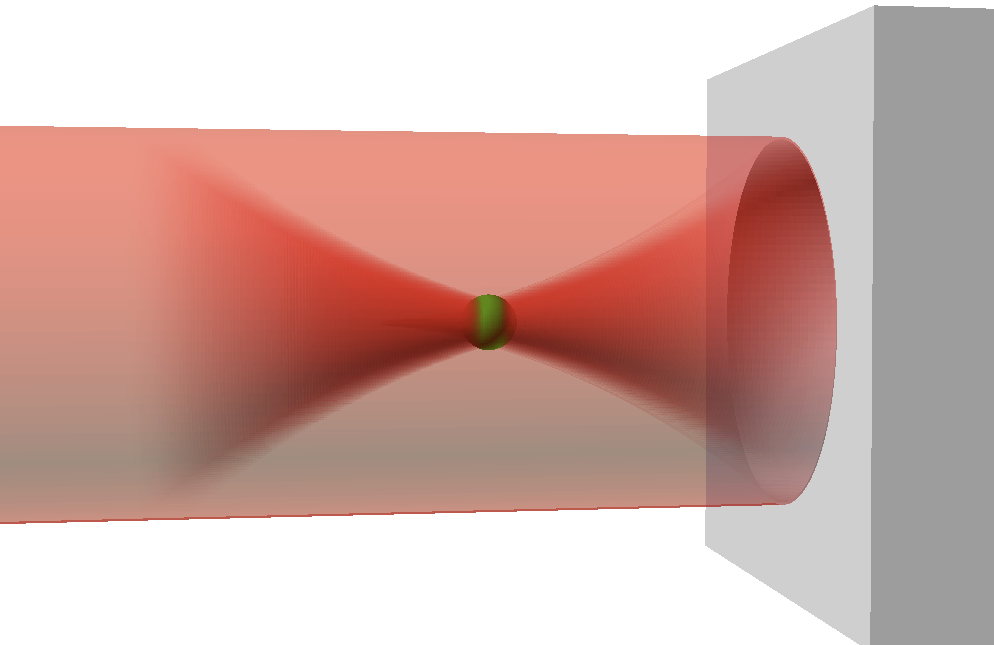
The development of thermodynamics ushered in the infamous industrial revolution. Whilst, the fast development of nano-devices has required a deeper and fresh look at thermodynamics at the nanoscopic scale. Here however, dynamics of system are highly susceptible to fluctation theorems arising due influences from the environment and often fall within non-equilibrium thermodynamics.
Levitated optomechanics is a paradigm system for addressing foundational questions in physics. Here a single nanoparticle is levitated using tightly focused laser beams in ultrahigh vacuum, thereby isolating the particle from numerous sources of noise.
At southampton, we have already realised such a setup being able to cool and heat the particles center-of-mass motion which is confined in fixed volumetric region. Such an isolated nanoparticle therefore becomes an ideal system to test fundamental questions pertaining to thermodynamics.
This project will utalise the levitated nanoparticle and controllably study single particle thermodynamics. Realising a nano-heat engine as well as pioneer study in the thermodynamics of a single particle system, specifically looking at the non-equilibrium regime. Understanding of such nanodevices that are also at the interface of quantum and classical physics and therefore key to the quantum industrial revolution.
We are looking for highly motivated and hands-on candidates with an interest to set up and work with sophisticated experiments. Good knowledge and understanding of optics and thermodynamics is required. A working knowledge and hands on experience of quantum optics is desirable. Experience of any of the following would be advantageous: feedback stabilization with FPGA digital electronics, work with Ultra-high vacuum systems, fibre and diode lasers. As well as, programming in Matlab, Python and Labview for data analysis and data-acquisition.
[For more information, please visit our group website at http://phyweb.phys.soton.ac.uk/matterwave/html/ and contact prof. Hendrik Ulbricht (h.ulbricht@soton.ac.uk).
Machine Learning Strategies for Manipulating Levitated Optomechanics in the Quantum Domain
This project is about applying computational methods using artificial intelligence algorithms to make the next step with our experiments towards the quantum domain. In detail, we want to
· Using supervised learning techniques with artificial neural networks (ANNs) to reconstruct/estimate the position and momentum state of a levitated nanoparticle from an optical intensity signal.
· Using reinforcement learning techniques to train an ANN to cool the motion of a levitated nanoparticle.
· Applying these techniques in real-time in an FPGA to cool and control the motion of a levitated nanoparticle.
· Using techniques from control theory and machine learning to predict behaviour of the system and control it.
· Using machine learning, control theory and ANNs to attempt to prepare mesoscopic quantum states of the motion of a levitated Nanoparticle.
This project will be within the very successful, productive and well-funded research group of Prof Ulbricht, the Quantum Nanophysics and Matterwave interferometry group (http://phyweb.phys.soton.ac.uk/matterwave/html/pub.html ), consisting of about ten post-doctoral researchers and PhD students. The group has multi-disciplinary expertise in experimental atomic, molecular and optical (AMO) and Nano-Physics as well as quantum optics theory and computation in regards of FPGA implementation. We operate three optical traps simultaneously for a number of different experiments, all based on feedback control. The feedback schemes are based on homodyne detection and so-called continuous weak measurement. We further collaborate widely with experts in control theory, theoretical physics and industry. One of our experiments is the role model for a planned space mission by the European Space Agency (ESA). The direct industrial partner of this project is INWT Statistics, a data analyst company, who use machine learning protocols for various applications and are interested to expand their expertise to include also deep learning strategies. The interaction will be on a consultation bases at the beginning of this project, but can be intensified if promising and interesting.
Quantum sensing in dynamic environments
The UK has recently invested over a quarter of a billions pounds into the emerging field of quantum technology, and this has spurred similar investment worldwide. As technological devices become ever smaller, we are quickly approaching the scale where quantum mechanics becomes predominant over classical physics. States of matter (energy, position, momentum, etc.) will become ‘superpositions’ rather than definitive values, and components can become ‘entangled’ over large distances thus affecting each other with no clear physical connection. This could lead to severe malfunctions if we keep pushing classical technology approaches, hence the need to identify ways in which these strange quantum effects can become advantageous instead.
One area is in the field of sensing. Atoms are formed of massive nuclei surrounded by electrons, and thus are sensitive to electric and magnetic fields, gravity and non-inertial forces (accelerations and rotation). We now have the ability to trap and cool atoms within ultra-high vacuum chambers such that we have dense samples of atoms which we can manipulate and measure for long periods of time. Moreover, when atoms are cooled to very low temperatures they begin to exhibit wave-like properties which can be used to form atomic interferometers. This improves measurement precision and is the basis behind modern atomic clocks.
However, making cold atom sensors is one half of the story. The national quantum technology program aims to unshackle quantum technology from the laboratory. Therefore our atomic sensors need to be compact, integrated and robust enough to function in a variety of different environments. This is a challenging task as cold atom technology is still in the early stages of development and little research has been undertaken to ensure they can work whilst experiencing mechanical vibrations, thermal fluctuations, and sudden jolts. One also needs to add on to this the need for low power operation, small size and weight and simple controls, to make these systems commercially viable.
Our group has been working on these problems for several years, primarily focusing on miniaturising and integrating cold atom sources. We are now moving into exploring methods to make the sensing operation more robust. This will follow two streams of research. 1) Using multiple cold atom source and measuring the difference between their signals. Any external vibration noise is common to both sensors and thus the difference is immune. We are exploring optical fibre based methods to couple these sensors. 2) By shortening the time between measurements, one can reduce the effect of large accelerations and low frequency fluctuations, thus providing a higher dynamic range of measurement. While this can reduce the ultimate performance of the system, it will increase sampling rate and thus allow one to ‘average out’ the noise faster. We will be developing a high speed cold atom source for sensing accelerations and rotations coincidentally using dual atom interferometry.
Inductive ring traps for atomic gyroscopes
Collaboration with the University of Sussex and SYRTE - Observatoire de Paris
Ultra-cold atoms (at micro-Kelvin temperatures or below) provide some of the purest quantum states available as they are highly separated from the ‘noisy’ classical environments by the ultra-high vacuum they need. Over three decades of development in manipulating these atoms has provided physicists with a huge range of high precision tools, a deeper understanding of fundamental physics, and a number of practical applications beyond the laboratory. This latter aspect has led to a worldwide interest and funding into ‘quantum technology’ in which the stranger aspects of quantum physics (e.g. superposition and entanglement) are used for applications in sensing, communications and computing. This project forms part of the UK Quantum Technology Hub for Sensors and Metrology.
Laser cooled neutral atoms are especially useful as they have internal structure, mass and can be made sensitive (or insensitive) to electric, magnetic and gravitational fields. One important aspect is the ability to trap these particles for long periods of time, which increases their ability to sense forces. A suitable analogy is a laser interferometer which can record minute variation in length via interference between two beams. The longer the arms of the interferometer, the more sensitive the device – as highlighted in the LIGO detector. At very low temperatures, atoms begin to exhibit (de Broglie) wave-like properties in exactly the same way and we can form similar interferometric sensors.
A Sagnac interferometer has a ring geometry which allows the (atomic or light) waves to circuit nearly indefinitely. The sensitivity of the interferometer is proportional to the area enclosed multiplied by the number of cycles around it. Thus one can have huge increases of sensitivity whilst maintaining small overall dimension. This requires very low loss per circuit/cycle. There is, therefore, a large interest in making cold atom Sagnac interferometers with low losses because of the huge potential gain in sensitivity. This can be achieved be ensuring the trapping ring is highly uniform with no ‘input and output’ ports. This has been difficult to achieve as most magnetic traps which use wires require connection to an external current source.
Induced currents, however, do not require such connections and also allow for high power electronics to be situated externally to the ultra-high vacuum – greatly simplifying the experimental design. A trap based on such currents is formed by producing a ring shaped magnetic minima near the inner radius of a millimetre sized metallic ring. At this point there is a cancellation between the external and induced microwave fields which atoms are attracted towards.
Such a trap has yet to be experimentally verified, however there has been significant theoretical research. This experimental PhD, supported by theory from the University of Sussex (joint supervision from Professor Barry Garraway) will develop the first inductive ring trap using microfabrication technology, microwave electronics and laser cooling and trapping of atoms. Support on magnetic traps and atomic gyroscopes will be provided by the Observatoire de Paris.
Atom sources for integrated quantum sensors
Collaboration with National Physical Laboratory and the University of Birmingham
Atomic clocks are an underpinning technology amongst a surprising amount of day-to-day applications, from navigation and communications, to finance and the national grid. Today, some of the leading atomic clocks are based on optically trapped arrays of Strontium atoms which have been cooled to near absolute zero temperatures. The current record for accuracy is on the order of a few parts in 10-19 of a second. This is equivalent to 100 milliseconds inaccuracy over the lifetime of the universe! We are nearing the stage where we will redefine the second from the current caesium standard, and the ‘strontium lattice clock’ is a strong contender.
One of major technological challenges in building a strontium lattice clock is the source of strontium itself. One requires these atoms in a vapour phase – free floating in an ultra-high vacuum chamber – but the low vapour pressure of Strontium means that a hot oven is required. This has several disadvantages: the hotter the atom source, the more difficult to trap and cool the atoms, and so one has a lower signal to noise; a lengthy ‘Zeeman slower’ is required to collect sufficient atoms which greatly complicated the clock and results in spurious magnetic fields; the ‘clock transition’ is very sensitive to blackbody energy shifts induced by hot nearly objects thus limiting the clock accuracy. There is a significant interest in making atomic clocks as small and portable as possible, particularly in the area of navigation.
This PhD project aims to look at alternative strontium vapour sources which avoid the use of a hot oven and complex Zeeman slower. An intriguing effect has recently been demonstrated where strontium oxide produced pure strontium oxide under weak UV laser irradiation. The exact mechanism and optimum arrangement is still unknown, and a thorough exploration of the parameter space is required. The same effect has been seen in Ytterbium oxides, which is another contender for the redefinition of a second, albeit in an ion trap. Therefore, part of this project is to thoroughly explore and understand this mechanism. The second approach is to adapt the new voltage-controlled alkali source developed at NIST, for alkaline earth atoms. This exciting device allows one to both source and sink atoms in a highly controllable manner which is very advantageous for future atomic clocks. As part of the project, the student will also be involved in the development of alkali and alkaline-earth reference cells using microfabrication techniques.
The candidate will have a strong background in atomic and optical physics, and ideally have some experience in inorganic chemistry and surface science.